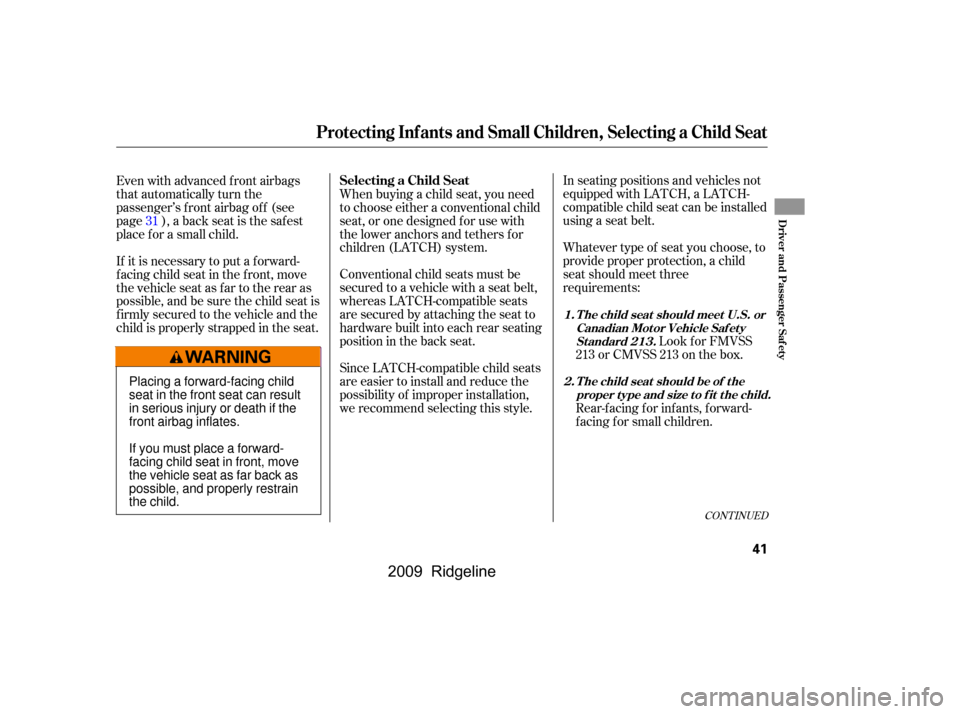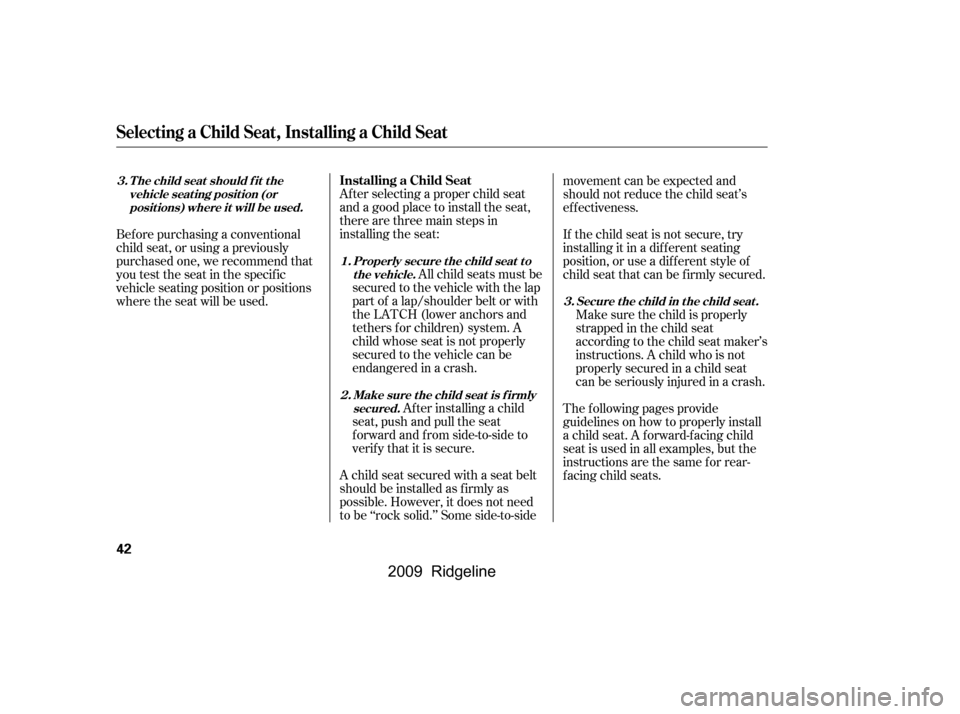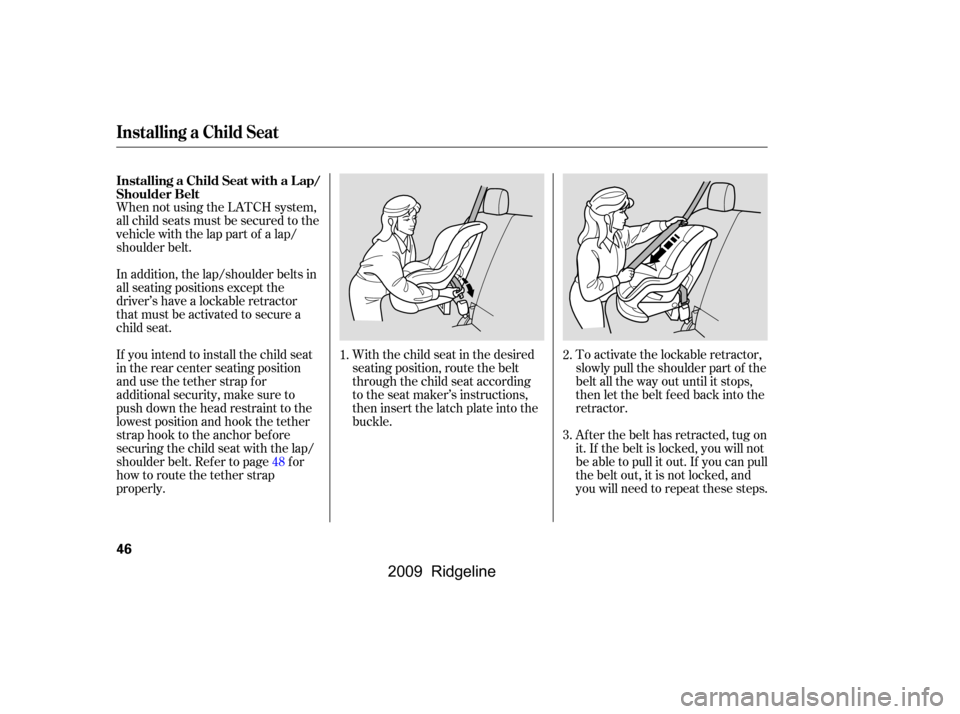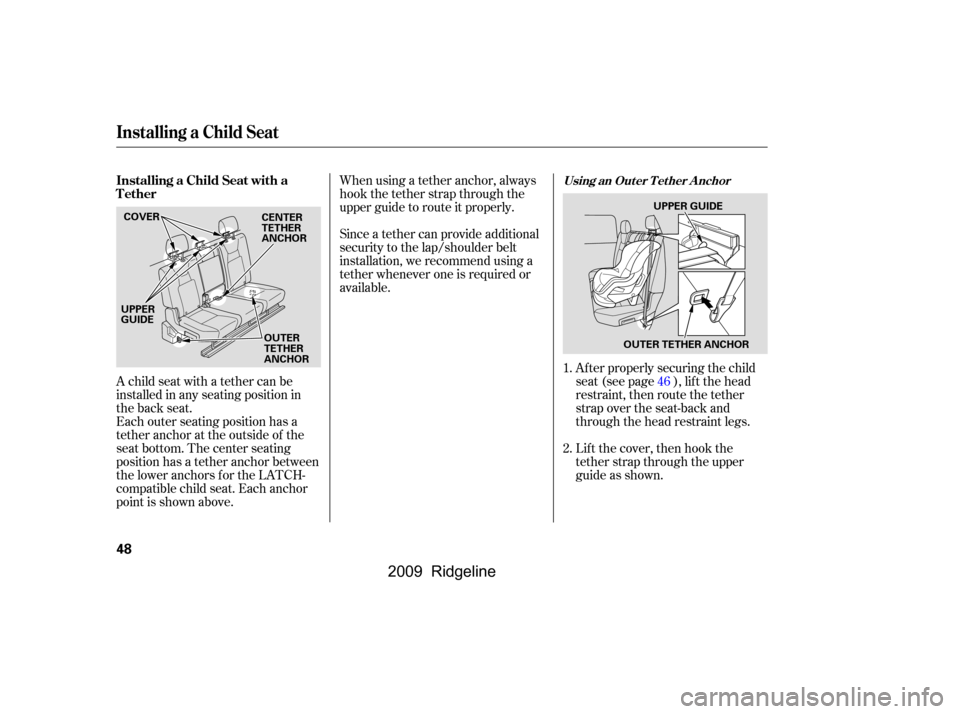Page 45 of 427

Since LATCH-compatible child seats
are easier to install and reduce the
possibility of improper installation,
we recommend selecting this style.
In seating positions and vehicles not
equipped with LATCH, a LATCH-
compatible child seat can be installed
using a seat belt.
Whatever type of seat you choose, to
provide proper protection, a child
seat should meet three
requirements:
Look f or FMVSS
213 or CMVSS 213 on the box.
Rear-facing for infants, forward-
f acing f or small children.
When buying a child seat, you need
to choose either a conventional child
seat, or one designed f or use with
the lower anchors and tethers for
children (LATCH) system.
Conventional child seats must be
secured to a vehicle with a seat belt,
whereas LATCH-compatible seats
are secured by attaching the seat to
hardware built into each rear seating
position in the back seat.
If it is necessary to put a f orward-
f acing child seat in the f ront, move
the vehicle seat as far to the rear as
possible, and be sure the child seat is
f irmly secured to the vehicle and the
child is properly strapped in the seat.
Even with advanced front airbags
that automatically turn the
passenger’s front airbag off (see
page ), a back seat is the saf est
place f or a small child.
31
CONT INUED
Protecting Inf ants and Small Children, Selecting a Child Seat
Selecting a Child Seat
T he child seat should meet U.S. or
Canadian Mot or Vehicle Saf et y
St andard 213.
T he child seat should be of the
proper type and size to f it the child.
1.
2.
Driver and Passenger Saf ety
41
Placing a forward-facing child
seat in the front seat can result
in serious injury or death if the
front airbag inflates.
Ifyoumustplaceaforward-
facing child seat in front, move
the vehicle seat as far back as
possible, and properly restrain
the child.
�����—�����—�����y�
�������������y���
�(�����������y���������y
2009 Ridgeline
Page 46 of 427

Af ter selecting a proper child seat
and a good place to install the seat,
there are three main steps in
installing the seat:All child seats must be
secured to the vehicle with the lap
part of a lap/shoulder belt or with
the LATCH (lower anchors and
tethers for children) system. A
child whose seat is not properly
secured to the vehicle can be
endangered in a crash.
Af ter installing a child
seat, push and pull the seat
f orward and f rom side-to-side to
verify that it is secure.
A child seat secured with a seat belt
should be installed as f irmly as
possible. However, it does not need
to be ‘‘rock solid.’’ Some side-to-side movement can be expected and
should not reduce the child seat’s
ef f ectiveness.
If the child seat is not secure, try
installing it in a dif f erent seating
position, or use a dif f erent style of
child seat that can be f irmly secured.
Bef ore purchasing a conventional
child seat, or using a previously
purchased one, we recommend that
you test the seat in the specif ic
vehicle seating position or positions
where the seat will be used.
Make sure the child is properly
strappedinthechildseat
according to the child seat maker’s
instructions. A child who is not
properly secured in a child seat
can be seriously injured in a crash.
The f ollowing pages provide
guidelines on how to properly install
a child seat. A f orward-f acing child
seat is used in all examples, but the
instructions are the same f or rear-
f acing child seats.
Selecting a Child Seat, Installing a Child Seat
Installing a Child Seat
Properly secure t he child seat t o the vehicle.
Make sure t he child seat is f irmlysecured.
T he child seat should f it the
vehicle seat ing posit ion (orposit ions) where it will be used.
Secure the child in the child seat.
1.
2. 3.
3.
42
�\f���—�\f���—�\f���y�
���������
���y���
�(���������\f�y�\f�\f�����y
2009 Ridgeline
Page 47 of 427

To install a LATCH-compatible child
seat:Make sure there are no objects
near the anchors that could
prevent a secure connection
between the child seat and the
anchors. When using the tether strap on
the child seat, attach the tether
strap hook to the center tether
anchor bef ore installing the child
seat to the lower anchors f or the
LATCH system, because the
center tether anchor is positioned
behind the child seat.
If needed, move the seat belt
buckle or tongue away f rom the
lower anchors.
Your vehicle is equipped with
LATCH (lower anchors and tethers
f or children) at the rear seats.
The lower anchors are located
between the seat-back and seat
bottom, and are to be used only with
a child seat designed f or use with
LATCH.
The location of each lower anchor is
indicated by a small button above the
anchor point.
Whenever using the center tether
anchor point, make sure to push
down the head restraint to the lowest
position, route the strap over the
seat-back, then around the upper
guide bef ore attaching the tether
strap hook to the center tether
anchor (see page ).
1.
2.3.
48
CONT INUED
On the center seating position
Installing a Child Seat
Installing a Child Seat with
LATCH
Driver and Passenger Saf ety
43
BUTTON UPPERGUIDE
CENTER TETHER ANCHOR
LATCH
ANCHOR
POINTS
�\f���—�\f���—�\f���y�
�������������y���
�(���������\f�y�\f�\f�����y
2009 Ridgeline
Page 50 of 427

When not using the LATCH system,
all child seats must be secured to the
vehicle with the lap part of a lap/
shoulder belt.With the child seat in the desired
seating position, route the belt
through the child seat according
to the seat maker’s instructions,
then insert the latch plate into the
buckle.To activate the lockable retractor,
slowly pull the shoulder part of the
belt all the way out until it stops,
then let the belt f eed back into the
retractor.
Af ter the belt has retracted, tug on
it. If the belt is locked, you will not
be able to pull it out. If you can pull
thebeltout,itisnotlocked,and
you will need to repeat these steps.
In addition, the lap/shoulder belts in
all seating positions except the
driver’s have a lockable retractor
that must be activated to secure a
child seat.
If you intend to install the child seat
in the rear center seating position
and use the tether strap for
additional security, make sure to
push down the head restraint to the
lowest position and hook the tether
strap hook to the anchor bef ore
securing the child seat with the lap/
shoulder belt. Ref er to page f or
how to route the tether strap
properly.
1.
2.
3.
48
Installing a Child Seat with a L ap/
Shoulder Belt
Installing a Child Seat
46
�\f���—�\f���—�\f���y�
�������������y���
�(���������\f�y�\f�\f���
�y
2009 Ridgeline
Page 51 of 427
Af ter conf irming that the belt is
locked, grab the shoulder part of
the belt near the buckle, and pull
up to remove any slack from the
lap part of the belt. Remember, if
the lap part of the belt is not tight,
the child seat will not be secure.Push and pull the child seat
f orward and f rom side-to-side to
verify that it is secure enough to
stay upright during normal driving
maneuvers. If the child seat is not
secure, unlatch the belt, allow it to
retract f ully, then repeat these
steps.
To remove slack, it may help to
putweightonthechildseat,or
push on the back of the seat while
pulling up on the belt. To deactivate the lockable retractor
and remove a child seat, unlatch the
buckle, unroute the seat belt, and let
the belt fully retract.
4. 5.
Installing a Child Seat
Driver and Passenger Saf ety
47
�\f���—�\f���—�\f���y�
�����������\f�y���
�(���������\f�y�\f�\f�����y
2009 Ridgeline
Page 52 of 427

When using a tether anchor, always
hook the tether strap through the
upper guide to route it properly.
Since a tether can provide additional
security to the lap/shoulder belt
installation, we recommend using a
tether whenever one is required or
available.
Each outer seating position has a
tether anchor at the outside of the
seat bottom. The center seating
position has a tether anchor between
the lower anchors f or the LATCH-
compatible child seat. Each anchor
point is shown above. Lif t the cover, then hook the
tether strap through the upper
guide as shown.
Af ter properly securing the child
seat (see page ), lif t the head
restraint, then route the tether
strap over the seat-back and
through the head restraint legs.
A child seat with a tether can be
installed in any seating position in
the back seat. 1.
2.46
Installing a Child Seat
Installing a Child Seat with a
TetherUsing an Out er T et her A nchor
48
COVER
UPPER
GUIDE UPPER
GUIDE
CENTER
TETHER
ANCHOR
OUTER
TETHER
ANCHOR OUTER TETHER ANCHOR
�\f���—�\f���—�\f���y�
�������������y���
�(���������\f�y�\f�\f�����y
2009 Ridgeline
Page 55 of 427

The f ollowing pages give
instructions on how to check proper
seat belt f it, what kind of booster
seat to use if one is needed, and
important precautions f or a child
who must sit in f ront.
To determine if a lap/shoulder belt
properly f its a child, have the child
put on the seat belt, then ask
yourself :
Does the child sit all the way back
against the seat?
Do the child’s knees bend
comf ortably over the edge of the
seat?
When a child reaches the
recommended weight or height limit
for a forward-facing child seat, the
child should sit in a back seat on a
booster seat and wear a lap/shoulder
belt.
1.
2.
CONT INUED
Protecting L arger Children
Checking Seat Belt Fit
Driver and Passenger Saf ety
51
Allowing a child age 12 or under
to sit in front can result in injury
or death if the passenger’s front
airbag inflates.
If a child must ride in front,
move the vehicle seat as far
back as possible, use a booster
seat if needed, have the child
sit up properly and wear the
seat belt properly.
�����—�����—�����y�
�����������
�y���
�(�����������y���������y
2009 Ridgeline
Page 56 of 427

Booster seats can be high-back or
low-back. Whichever style you select,
make sure the booster seat meets
f ederal saf ety standards (see page) and that you f ollow the booster
seat maker’s instructions.
If a child who uses a booster seat
must ride in f ront, move the vehicle
seat as far back as possible and be
sure the child is wearing the seat
belt properly.
A child may continue using a booster
seat until the tops of their ears are
even with the top of the vehicle’s or
booster’s seat-back. A child of this
height should be tall enough to use
the lap/shoulder belt without a
booster seat.
Does the shoulder belt cross
between the child’s neck and arm?
Is the lap part of the belt as low as
possible, touching the child’s
thighs?
Will the child be able to stay
seated like this f or the whole trip?
If you answer yes to all these
questions, the child is ready to wear
the lap/shoulder belt correctly. If
you answer no to any question, the
child needs to ride on a booster seat. A child who has outgrown a forward-
f acing child seat should ride in a
back seat and use a booster seat
until the lap/shoulder belt f its them
properly without the booster.
Some states and Canadian provinces
also require children to use a booster
seat until they reach a given age or
weight (e.g., 6 years or 60 lbs). Be
sure to check current laws in the
states or provinces where you intend
to drive.
3.
4.
5.
41
Protecting L arger Children
Using a Booster Seat
52
�\f���—�\f���—�\f���y�
������\f������y���
�(���������\f�y�\f�\f�����y
2009 Ridgeline